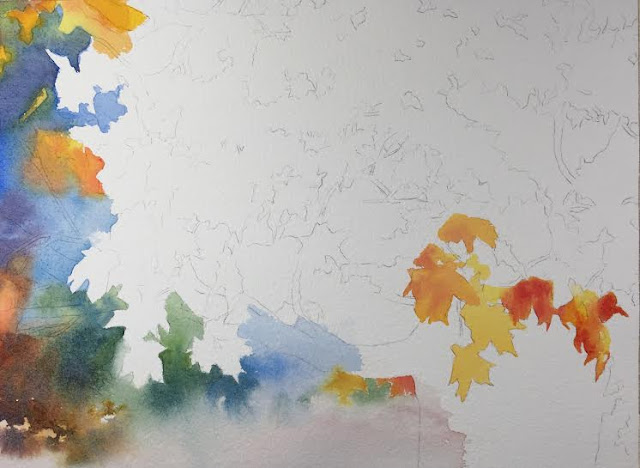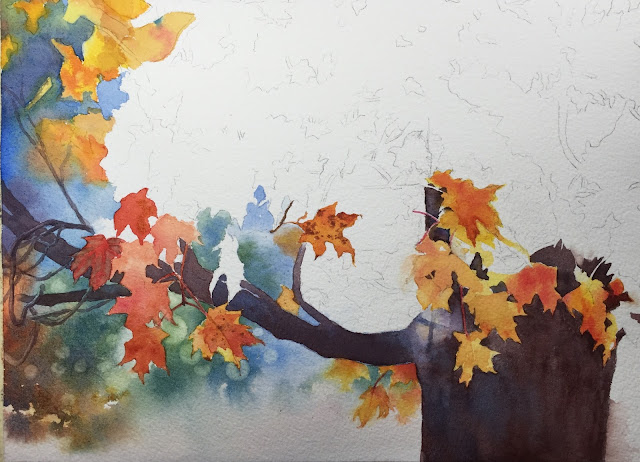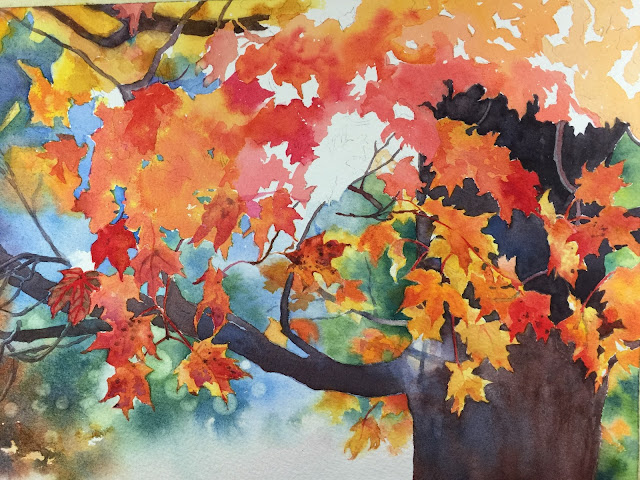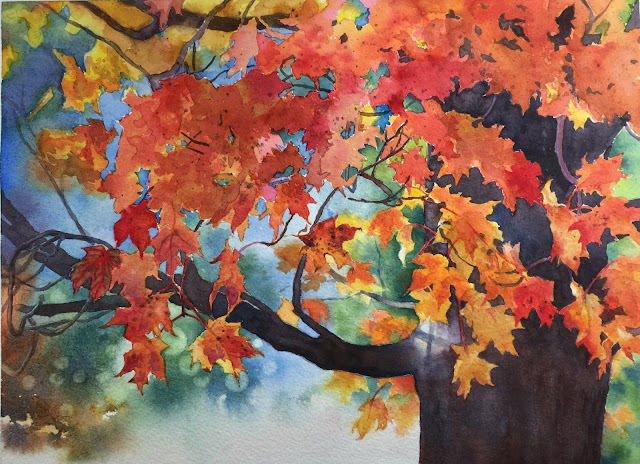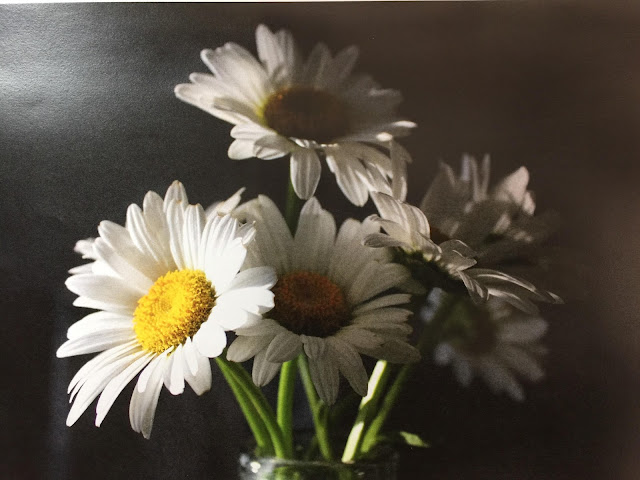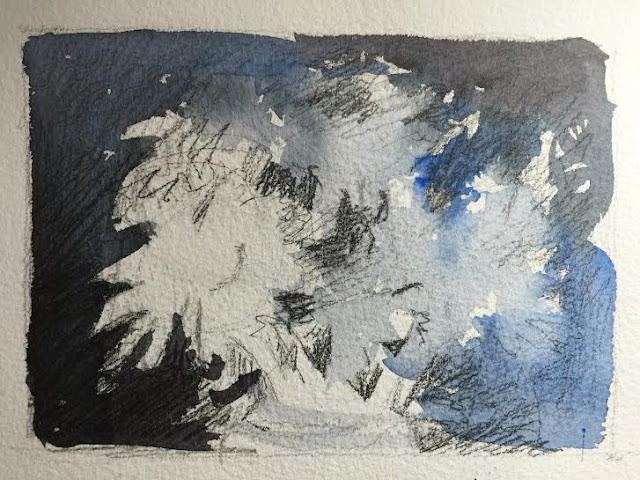This is the photo I took of an autumn tree that I loved because of the colors and the blue sky behind the leaves.
I started painting some of the leaves on the right. I used cadmium yellow on all of them but on some dropped in winsor red and a Daniel Smith color called quinacridone sienna (if you don't have this color, you can make it by mixing quinacridone gold + burnt sienna + quinacridone rose). I used winsor red and quinacridone rose on most of the brighter red leaves and quin. sienna on the orangier leaves.
I did the background starting in the upper left corner. I painted wet into wet for the blue sky only (not the leaves) in ultramarine blue. I then painted the leaves while the blue was still wet with cadmium yellow. I painted quickly and only painted halfway down the paper with the blue and then went up with the yellow so the paper didn't dry and the yellow would blend in with the blue. Some areas up top turned green which I wanted it to do. Brought the ultramarine down and then added a violet mix of winsor red + ultramarine. I kept working down quickly and got to the next group of leaves again with some blue and violet. Once I got to the lower left, I added a bit of cadmium orange hue from Daniel Smith, under the violet, keeping it light. Then I used burnt sienna under that and dropped in other colors to it such as quin. sienna, cobalt, violet, and quin gold. All wet into wet. I tried to make it look like distant and blurred branches and leaves. As you go from the lower left corner to the right, it starts to transition into sap green + ultramarine. I put clear water down along the bottom of the picture and dropped in a very light wash of a violet with alizarin crimson + cobalt blue. It is very very light. While that was still wet, I finished under the big branch by adding blues and greens and adding a few leaves.
I did a few more leaves and then started painting the big trunk and branch with cobalt blue also noting that there is a highlight where the big branch comes out of the trunk that I just used water to paint with instead of the blue. I then dropped in a little quin. rose around that light.
When the cobalt blue dried, I painted a mix of burnt sienna + winsor red + ultramarine over the top of it, being careful to keep the light area.
I kept painting out to the branches on the left, keeping them a little light because I didn't want to call too much attention to them.
I filled in with ultramarine and sap green above the branch. I also added some circle shapes below the branch with a small round scrub brush.
Pretty much I just filled in the rest of the picture. I did blend the leaves more above so they were so individual, using all the same colors as before.
Here is my finished painting. I spattered some dots on the leaves with burnt sienna and also glazed some of the leaves with burnst sienna also just to make them a little darker in tone so some of the brighter leaves would stand out.
Monday, November 23, 2015
Wednesday, October 21, 2015
BLUEBIRD - Class Project October 2015
Here is a photo of a bluebird that flew into my yard and landed on the fence post. I was able to take a picture quickly. They are my absolute favorite bird and I wanted to paint it. I chose this for a beginner painting, although as I got into it saw that it wasn't so beginner. However, there are a lot of good techniques in this one and it is excellent for beginners to do.
I am a little hesitant about the background and not sure how it will come out. The values are very similar within the painting but I will give it a shot.
I started painting the blue part of the bird, but I also prepared the rust color for the breast because there are parts like the upper part near the top of the wing where the rust and blue meet and blurs out. I wanted to paint these at the same time. I used a mix of cobalt blue and cerulean blue in whatever ratio you'd like but I used about half and half. I just painted the blue straight on and didn't worry about shading or anything. This I will add later. After the blue was applied, I added the rust color which is raw sienna and alizarin. Do not add too much alizarin. Occasionally I added some yellow ochre in areas and quinacridone rose. There is also a deeper more violet area of the upper breast that I painted by adding cobalt blue to the mixture. It should look like a rusty violet.
After doing the rust color, I added the gray on the underbelly with payne's gray and cadmium red lt. Later on after it dries I scrubbed out some of the gray and added the white feathery feel to it. I dropped in a little cobalt blue in places also.
After that I went back into the blue of the bird and added some darker areas with cobalt and maroon perylene. I touched in some quinacridone rose in some areas as well and at time mixed the rose with the cobalt blue to get a violet. The gray I used for the underbelly I also added to parts of the tail and the wing and to the right of the eye.
I put in the eyeball and beak. I used payne's gray for the eye and for the beak but also added cobalt blue above in the middle of the beak, being careful to leave a highlight on the top.
After doing this part of the bird, I started the background. I wanted to do the background before putting any more darks on the bird because I wasn't sure yet how dark to make it.
I used sap green mostly for the background. I dropped in cobalt blue to a few areas you can see and also yellow ochre. I added a little cobalt to the sap green when I needed a little darker green. When the background was not too wet, I added some branches with the same colors. It's important for the paper to not be too wet or else it will blur too much. Timing is everything and it's not easy! Best to practice.
After doing the background I darkened up the bird a bit. Then I did the fence post. A drybrush technique was used here. I used payne's gray and cadmium red lt. Using the side of the brush I made this textural effect. While wet, I dropped in a bit of burnt sienna. I used cobalt blue and burnt sienna for the iron rod the bird is standing on. There are touches of cadmium red lt. in there too.
This is the finished painting. I still haven't decided about the background and I think I am just going to leave it and say it is a bluebird study! I am anxious to see what the class does with it.....a lot of times I get good ideas from them!!!
I decided the background needed fixing and the bird needed darkening a bit, so here is the newer finished version. I also darkened the fence post a bit. Hopefully the bird stands out a bit better. I lightened up around it's head also by scrubbing a little with Mr. Clean Magic Eraser. That stuff is amazing!
I am a little hesitant about the background and not sure how it will come out. The values are very similar within the painting but I will give it a shot.
I started painting the blue part of the bird, but I also prepared the rust color for the breast because there are parts like the upper part near the top of the wing where the rust and blue meet and blurs out. I wanted to paint these at the same time. I used a mix of cobalt blue and cerulean blue in whatever ratio you'd like but I used about half and half. I just painted the blue straight on and didn't worry about shading or anything. This I will add later. After the blue was applied, I added the rust color which is raw sienna and alizarin. Do not add too much alizarin. Occasionally I added some yellow ochre in areas and quinacridone rose. There is also a deeper more violet area of the upper breast that I painted by adding cobalt blue to the mixture. It should look like a rusty violet.
After doing the rust color, I added the gray on the underbelly with payne's gray and cadmium red lt. Later on after it dries I scrubbed out some of the gray and added the white feathery feel to it. I dropped in a little cobalt blue in places also.
After that I went back into the blue of the bird and added some darker areas with cobalt and maroon perylene. I touched in some quinacridone rose in some areas as well and at time mixed the rose with the cobalt blue to get a violet. The gray I used for the underbelly I also added to parts of the tail and the wing and to the right of the eye.
I put in the eyeball and beak. I used payne's gray for the eye and for the beak but also added cobalt blue above in the middle of the beak, being careful to leave a highlight on the top.
After doing this part of the bird, I started the background. I wanted to do the background before putting any more darks on the bird because I wasn't sure yet how dark to make it.
I used sap green mostly for the background. I dropped in cobalt blue to a few areas you can see and also yellow ochre. I added a little cobalt to the sap green when I needed a little darker green. When the background was not too wet, I added some branches with the same colors. It's important for the paper to not be too wet or else it will blur too much. Timing is everything and it's not easy! Best to practice.
After doing the background I darkened up the bird a bit. Then I did the fence post. A drybrush technique was used here. I used payne's gray and cadmium red lt. Using the side of the brush I made this textural effect. While wet, I dropped in a bit of burnt sienna. I used cobalt blue and burnt sienna for the iron rod the bird is standing on. There are touches of cadmium red lt. in there too.
This is the finished painting. I still haven't decided about the background and I think I am just going to leave it and say it is a bluebird study! I am anxious to see what the class does with it.....a lot of times I get good ideas from them!!!
I decided the background needed fixing and the bird needed darkening a bit, so here is the newer finished version. I also darkened the fence post a bit. Hopefully the bird stands out a bit better. I lightened up around it's head also by scrubbing a little with Mr. Clean Magic Eraser. That stuff is amazing!
DAISIES - Intermediate Classwork October 2015
I thought this picture I took of daisies came out pretty, so I decided to paint them and thought they would make a good class project.
First I did a very rough thumbnail sketch with pencil and watercolor on top just to determine the values and whether this would make a pleasing painting.
Then I started painting the background first, but before I did that I wet the flowers with plain water because I wanted the background to be a soft edge against some of the flowers on the right. I used payne's gray mixed with cobalt blue. Sometimes I added more cobalt to look more blue and other times I used more payne's gray. You can tell in the picture when I did that.
While the background was still wet I painted the shadow side of the flowers (cobalt blue with a touch of payne's gray) in the middle and the right. If the background started to dry (which it did) I gave it a spritz of water and that caused droplets which I like, but this is my demo picture and my actual one I finished didn't have this effect.
I was not super careful with getting all the petals correct and worked quickly. I didn't want this picture to be so exact and tight.
I then painted the flower centers. I started with the very left flower. That center should be the brightest and it doesn't have any blue glaze over it like the others do so the colors should come out a little brighter. I painted the whole center with cadmium yellow and cadmium yellow light, and pulled the color through to some of the petals where I saw some yellow in them. I added some cadmium red light around the edges of the centers to give it more warmth and then I touched in some cobalt blue around the bottom edge. I did that same procedure with the other centers but looking at the photo for differences in shape and color for each one. Also I started to add the darks of the background in between some of the petals and the stems.
Then I did the stems which I used the cobalt blue and cadmium yellow light to achieve. One of the stems is very white which I liked and left alone except to give it a very light wash of cadmium yellow light. I basically made a very light green and painted that first on the stems. (From this photo it doesn't look very light but it is) I then made the green a little darker by adding more blue and then painted the darker side of the stem when almost dry but wet enough to make a soft edge. This takes a little patience to wait for the right timing to paint that in. If you mess up, you can always just scrub out a highlight. This works as well and makes a soft edge.
There are shadows on the petals and I painted those with cobalt blue and maroon perylene. I used the same colors and the background to fill in the glass vase and made sure the stem colors were carried down into it. Keep a highlight around the rim and just a few other highlights in there but it is mostly observing the glass and see what you see. There are no tricks to doing glass really....just paint what you see!
First I did a very rough thumbnail sketch with pencil and watercolor on top just to determine the values and whether this would make a pleasing painting.
Then I started painting the background first, but before I did that I wet the flowers with plain water because I wanted the background to be a soft edge against some of the flowers on the right. I used payne's gray mixed with cobalt blue. Sometimes I added more cobalt to look more blue and other times I used more payne's gray. You can tell in the picture when I did that.
While the background was still wet I painted the shadow side of the flowers (cobalt blue with a touch of payne's gray) in the middle and the right. If the background started to dry (which it did) I gave it a spritz of water and that caused droplets which I like, but this is my demo picture and my actual one I finished didn't have this effect.
I was not super careful with getting all the petals correct and worked quickly. I didn't want this picture to be so exact and tight.
I then painted the flower centers. I started with the very left flower. That center should be the brightest and it doesn't have any blue glaze over it like the others do so the colors should come out a little brighter. I painted the whole center with cadmium yellow and cadmium yellow light, and pulled the color through to some of the petals where I saw some yellow in them. I added some cadmium red light around the edges of the centers to give it more warmth and then I touched in some cobalt blue around the bottom edge. I did that same procedure with the other centers but looking at the photo for differences in shape and color for each one. Also I started to add the darks of the background in between some of the petals and the stems.
Then I did the stems which I used the cobalt blue and cadmium yellow light to achieve. One of the stems is very white which I liked and left alone except to give it a very light wash of cadmium yellow light. I basically made a very light green and painted that first on the stems. (From this photo it doesn't look very light but it is) I then made the green a little darker by adding more blue and then painted the darker side of the stem when almost dry but wet enough to make a soft edge. This takes a little patience to wait for the right timing to paint that in. If you mess up, you can always just scrub out a highlight. This works as well and makes a soft edge.
There are shadows on the petals and I painted those with cobalt blue and maroon perylene. I used the same colors and the background to fill in the glass vase and made sure the stem colors were carried down into it. Keep a highlight around the rim and just a few other highlights in there but it is mostly observing the glass and see what you see. There are no tricks to doing glass really....just paint what you see!
Wednesday, January 28, 2015
Seagull Along The Shore
| We are starting this painting in class. |
First I masked out the seagull. Then I was able to do a wash over the whole picture. I started wet on wet and used cerulean blue with a little quinacridone rose in it. Be careful not to add too much rose! While still wet I dropped in some color for the sand underneath. I used a mix of cadmium red and raw sienna.....for some darker areas I mixed in some cerulean blue to tone it down a bit. Then I added some quinacridone rose in places in the upper left of the seagull and a bit to the right bottom. If your painting is not dark enough, proceed to do the wash over again until you get the value you want. Be careful not to make it too dark or else the bird will get lost. You have to make the value of the bird darker than the water and if the water is too dark, the bird would have to be way too dark to show.
Now we can add some of the ripples in the water after everything has dried. I used the same colors of cadmium red and raw sienna and did add a little bit of cerulean blue to it. I made it really watery and applied the paint very loosely. By holding the brush handle further down the handle and not as close to the ferrule, you can obtain a looser stroke. Also be careful of the angle of the ripples. If they slant to much upward then it starts to look like rain!
I made the color a little less watery for the reflection of the seagull ....it's a darker shade there. I also added a bluer ripple of cerulean blue and burnt sienna. Don't make it too dark, though.
I put in the bluish shadow of the seagull using Thalo blue. The darker blue lines in the shadow I mixed thalo blue with some maroon perylene. When it was dry, I lifted the highlights out with a slightly wet brush and blotting.
Now it's time to work on the seagull. You can remove the masking and put the details of the bird on the paper by transferring the details with tracing paper.
There is reflective light from the water and sand showing on the underside of the bird. I painted the breast of the bird wet on dry using ultramarine blue mixed with quinacridone rose and raw sienna. Drop in yellow ochre and quinacridone rose in place where you see reflected light such as under the beak area and just above the legs. I went over this a few times to get the right value. After it was dry, I wiped out a few highlights with my brush above the left leg. After it all dried, I scrubbed with a soft brush the hard edge formed between the shadow and the white part of the bird. If you feel you would like to add some Thalo blue to parts you can. I did but very lightly in areas on top of the head.
Now to finish the rest of the seagull. Once you add the nice gray and black details of the back feathers, it will start to look like a seagull! I achieved the gray by mixing thalo blue and cadmium red in equal amounts. You might have to adjust one color or another to get the gray you think is correct. I would make sure it is not on the red and more on the blue side. There is a touch of violet shade on certain feathers though and you can adjust for that. The dark black is achieved by just mixing a stronger mix of the color. There are darker shadows under some of the feathers ....take note! This is the fun part! Any feathers you missed going around that are white, you can put in with some gouache. The beak is very hard to explain how to paint. I used raw sienna in the darker areas and used a dark to get the blacker areas using burnt sienna and ultramarine blue. Be careful to keep the highlighted areas of the beak white. You will have to zoom to get the details. The eye is also hard to explain. Zoom in and you will notice the eye is yellow ochre with some dark running through it.
The legs I did with raw sienna, ultramarine blue and quinacridone red mixed to get a dark, but also used raw sienna separate where it was highlighted. There is a light side.....zoom and you will see it.
Final details I added some white gouache to pull up some white feathers on the back and head area.
Subscribe to:
Posts (Atom)

